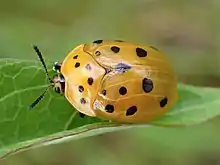| Chelymorpha cassidea | |
|---|---|
 | |
| Scientific classification | |
| Domain: | Eukaryota |
| Kingdom: | Animalia |
| Phylum: | Arthropoda |
| Class: | Insecta |
| Order: | Coleoptera |
| Infraorder: | Cucujiformia |
| Family: | Chrysomelidae |
| Genus: | Chelymorpha |
| Species: | C. cassidea |
| Binomial name | |
| Chelymorpha cassidea (Fabricius, 1775) | |
Chelymorpha cassidea, known generally as the Argus tortoise beetle or milkweed tortoise beetle, is a species of leaf beetle in the family Chrysomelidae.[1][2][3][4] It is found in the Caribbean and North America.[1][5][6]
Description
Adult
_color_variant.jpg.webp)
The beetle is 9 to 12 mm (0.35 to 0.47 in) long and is yellow to bright red with black spots. It is one of the largest leaf beetles native to North America. The name Argus comes from the mythical Greek giant Argus Panoptes, who was sometimes depicted with 100 eyes, because the beetle is able to stretch out its red head beyond its pronotum, as if it were a single red eye.[7] The species resembles a small turtle and is similar to a ladybug.[7][8]
Egg, larva, and pupa
_(18580819131).jpg.webp)
The Argus tortoise beetle lays eggs on leaves, in clusters of 15 to 30. The eggs hatch within 10 days. Its larvae are yellowish-green or orange-yellow. The larvae feed on leaves until they are fully grown, then they drop to the soil to pupate, overwintering as pupae before emerging as adults in the middle of summer.[7][9] It takes them almost three weeks to become pupae.[9]
Habitat
The beetle can be found throughout North America in meadows and roadsides. It can also be found in the Caribbean. It feeds on the foliage of plants, including milkweed, raspberry, maize, and sweet potato.[7] It can defoliate entire plants.[1][8] One plant that it feeds on is the morning glory, which has leaves that are protected by alkaloids. Some alkaloids can poison nerves and can be deadly to people and animals. It is possible that the beetle stores the alkaloids in its body to protect itself from predators.[10]
Predators
Predators of the beetle include the hymenopteran egg parasite Emersonella niveipes, the tachinid larval parasite Masicera exilis, and the predatory stink bug Apateticus bracteatus.[9]
References
- 1 2 3 "Chelymorpha cassidea Report". Integrated Taxonomic Information System. Retrieved 2018-05-01.
- ↑ "Chelymorpha cassidea species details". Catalogue of Life. Retrieved 2018-05-01.
- ↑ "Chelymorpha cassidea". GBIF. Retrieved 2018-05-01.
- ↑ "Chelymorpha cassidea Species Information". BugGuide.net. Retrieved 2018-05-01.
- ↑ Staines, C.L. "Catalog of the hispines of the World". Smithsonian Institution. Retrieved 2018-05-01.
- ↑ "North American Cryptocephalus species (Chrysomelidae, Cryptocephalinae)". Texas Entomology. Retrieved 2018-05-01.
- 1 2 3 4 National Audubon Society Field Guide To Insects & Spiders. Alfred A. Knopf, Inc. 1980. p. 604. ISBN 9780394507637.
- 1 2 John Andrew Eastman (2003). The Book of Field and Roadside: Open-country Weeds, Trees, and Wildflowers of Eastern North America. Stackpole Books. p. 39. ISBN 978-0-8117-2625-2.
- 1 2 3 Frank Hurlbut Chittenden (1889). Collected Papers. pp. 49–50.
- ↑ J. Raupp, Michael (October 29, 2007). "Bugs In Black Orange and Black III". Bug Of The Week. University of Maryland. Retrieved July 27, 2019.
External links
 Media related to Chelymorpha cassidea at Wikimedia Commons
Media related to Chelymorpha cassidea at Wikimedia Commons